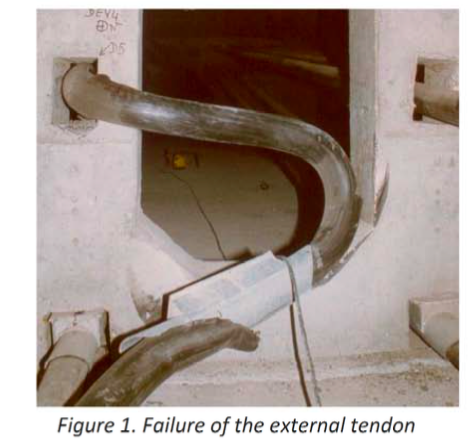Problematiche in ponti in ca Precompresso: cause, indagini, risanamento e prevenzione
Dal 23-25 2015, a GInevra in Svizzera si è svolto lo IABSE Conference: Structural Engineering: Providing Solutions to Global Challenges. RIprendiamo qui l'Abstract dell'articolo rimandando con un link al sito del congresso per leggere l'articolo in modo completo.
Failures of external Tendons in Prestressed Concrete Bridges: Causes, Investigations, Remediation and Prevention.
Bruno Godart
Universite? Paris-Est, IFSTTAR, Marne-la-Valle?e, France
Jean-Michel Lacombe, Christophe Aubagnac
Cerema, Sourdun & Autun, France
Abstract
In the the early 1980’s, an evolution in the grouting operations took place with the use of increasingly fluid grouts to facilitate the injection of the prestress ducts. During a gammagraphy campaign carried out on a box girder bridge under construction in 1994, anomalies were detected at the upper point of the ducts of the external prestressing tendons. Observations carried out after opening of some ducts highlighted a lack of filling and the presence of a product having the consistency of a wet and soft white paste. After presenting several cases of external tendon failures that occurred in the past years in France, the article describes the mechanism leading to severe grouting defects resulting in failures of tendons by a rather rapid corrosion. Then it presents the development of an investigation device based on dielectric capacity measurement that was applied during the campaign of investigations launched on all box girder bridges of the French national road network.
Keywords: Post-tensioning; bridges; tendons; grouting; rupture; causes; investigations; capacitive probe; repair; replacement.
1 Introduction
From the mid-70s, a change was made with the use of more and more fluid grout to facilitate the injection of prestressing longer ducts. From the 80s, the search for a greater fluidity was accompanied with the widespread use of superplasticizers. This change in the grout formulation and the grouting methods prevailed without checking the actual filling of the ducts on the sites. This leads to the occurrence of failures in external prestressing tendons, and it was observed in various countries, especially United States [1], but also France.
2 Cases of external tendon failures
Between 1994 and 2005, 5 cases of rupture of external prestressing tendon protected by cement grout in direct contact with steel strands were observed in France. When they broke, the tendons were respectively 8, 10, 18, 19 and 21 years old, with a mean age of 15 years. In this article, three cases of rupture of prestressing tendons are presented; they occurred chronologically in the following box girder bridges: the Val-Durance bridge, the Saint Cloud viaduct and a bridge in La Re?union island.
2.1 The Val-Durance bridge case
 The Val-Durance bridge is a prestressed concrete bridge that allows the A 51 to cross over the Durance. It was built by launching and commissioned in 1986. It has a total length of 288.60 m, comprises 6 spans with the following length:41m-4x51m-41m,andconsistsoftwo parallel box girders. For each of them, the prestress which is entirely external, is composed of 32 tendons made of 19 strands T15 (diameter 15 mm). The bare steel strands are located within a HDPE duct injected with cement grout in direct contact with the steel.
The Val-Durance bridge is a prestressed concrete bridge that allows the A 51 to cross over the Durance. It was built by launching and commissioned in 1986. It has a total length of 288.60 m, comprises 6 spans with the following length:41m-4x51m-41m,andconsistsoftwo parallel box girders. For each of them, the prestress which is entirely external, is composed of 32 tendons made of 19 strands T15 (diameter 15 mm). The bare steel strands are located within a HDPE duct injected with cement grout in direct contact with the steel.
In 1994, during an inspection, a team of the Regional Road and Bridge Laboratory (LRPC) of Aix-en-Provence discovered the rupture of a tendon that was about 250 meters long inside the downstream box girder (Fig. 1); the break occurred at an upper location, ahead of its anchorage, inside a crossbeam. The energy released during the rupture had projected the tendon toward its opposite end. The expertise conducted by the LRPC gave rise to the following conclusions:
